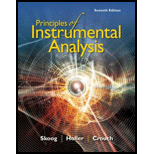
Principles of Instrumental Analysis
7th Edition
ISBN: 9781305577213
Author: Douglas A. Skoog, F. James Holler, Stanley R. Crouch
Publisher: Cengage Learning
expand_more
expand_more
format_list_bulleted
Concept explainers
Question
Chapter 23, Problem 23.6QAP
Interpretation Introduction
Interpretation:
The difference between gas-sensing probe and membrane electrode should be predicted.
Concept introduction:
Potentiometric titration are the simple titration that is used to measure the concentration of the given sample. No indicator is required in these titrations.
Expert Solution & Answer
Trending nowThis is a popular solution!

Students have asked these similar questions
Please draw, not just describe!
can you draw each step on a piece of a paper please this is very confusing to me
>
Can the molecule on the right-hand side of this organic reaction be made in good yield from no more than two reactants, in one step, by moderately heating
the reactants?
esc
?
A
O
O
•If your answer is yes, then draw the reactant or reactants in the drawing area below. You can draw the reactants in any arrangement you like.
• If your answer is no, check the box under the drawing area instead.
olo
18
Ar
Explanation
Check
BB
Click and drag to start drawing a structure.
2025 McGraw Hill LLC. All Rights Reserved. Terms of Use | Privacy Center Accessibility
Chapter 23 Solutions
Principles of Instrumental Analysis
Ch. 23 - Prob. 23.1QAPCh. 23 - Prob. 23.2QAPCh. 23 - Prob. 23.3QAPCh. 23 - Prob. 23.4QAPCh. 23 - Prob. 23.5QAPCh. 23 - Prob. 23.6QAPCh. 23 - Prob. 23.7QAPCh. 23 - Prob. 23.8QAPCh. 23 - Prob. 23.9QAPCh. 23 - List the advantages and disadvantages of a...
Ch. 23 - Prob. 23.11QAPCh. 23 - What arc the advantages of microfabricated ISEs?...Ch. 23 - Prob. 23.13QAPCh. 23 - Prob. 23.14QAPCh. 23 - Prob. 23.15QAPCh. 23 - The following cell was used for the determination...Ch. 23 - The following cell was used to determine the pSO4...Ch. 23 - The formation constant for the mercury(II) acetate...Ch. 23 - Prob. 23.19QAPCh. 23 - The cell Ag|AgCl(sat’d)||H+(a = x)|glass electrode...Ch. 23 - The following cell was found to have a potential...Ch. 23 - The following cell was found to have a potential...Ch. 23 - The following cell was found to have a potential...Ch. 23 - Prob. 23.24QAPCh. 23 - Prob. 23.25QAPCh. 23 - Prob. 23.26QAPCh. 23 - Prob. 23.27QAP
Knowledge Booster
Learn more about
Need a deep-dive on the concept behind this application? Look no further. Learn more about this topic, chemistry and related others by exploring similar questions and additional content below.Similar questions
- Name the structurearrow_forward> For each pair of substrates below, choose the one that will react faster in a substitution reaction, assuming that: 1. the rate of substitution doesn't depend on nucleophile concentration and 2. the products are a roughly 50/50 mixture of enantiomers. Substrate A Substrate B Faster Rate X CI (Choose one) (Choose one) CI Br Explanation Check Br (Choose one) C 2025 McGraw Hill LLC. All Rights Reserved. Terms of Use | Privacy A F10arrow_forwardHow to draw this mechanism for the foloowing reaction in the foto. thank youarrow_forward
- Predict the major products of the following organic reaction: Some important notes: CN A? • Draw the major product, or products, of the reaction in the drawing area below. • If there aren't any products, because no reaction will take place, check the box below the drawing area instead. • Be sure to use wedge and dash bonds when necessary, for example to distinguish between major products that are enantiomers. No reaction. Explanation Check Click and drag to start drawing a structure. 2025 McGraw Hill LLC. All Rights Reserved. Terms of Use Privacy Centerarrow_forwardDraw the major product of the following reaction. Do not draw inorganic byproducts. H3PO4 OHarrow_forwardPredict the major products of this organic reaction: HBr (1 equiv) Δ ? Some important notes: • Draw the major product, or products, of this reaction in the drawing area below. • You can draw the products in any arrangement you like. • Pay careful attention to the reaction conditions, and only include the major products. • Be sure to use wedge and dash bonds when necessary, for example to distinguish between major products that are enantiomers. • Note that there is only 1 equivalent of HBr reactant, so you need not consider the case of multiple additions. Explanation Check X ©2025 McGraw Hill LLC. All Rights Reserved. Terms of Use | Privacyarrow_forward
- For the structure below, draw the resonance structure that is indicated by the curved arrow(s). Be sure to include formal charges. :ÖH Modify the second structure given to draw the new resonance structure. Include lone pairs and charges in your structure. Use the + and - tools to add/remove charges to an atom, and use the single bond tool to add/remove double bonds.arrow_forwardUsing the table of Reactants and Products provided in the Hints section, provide the major product (with the correct stereochemistry when applicable) for questions below by selecting the letter that corresponds to the exact chemical structures for the possible product. OH conc Hydrochloric acid 40°C Temp A/arrow_forwardUsing arrows to designate the flow of electrons, complete the reaction below and provide a detailed mechanism for the formation of the product OH conc Hydrochloric acid 40°C Temp All chemical structures should be hand drawn on a piece of paper Paragraph BI UAE +varrow_forward
- draw out the following structures plesearrow_forwardDraw everything on a piece of paper outlining the synthesis from acetaldehyde to 2 cyclopentene carboxaldehyde using carbon based reagants with 3 carbons or fewers. Here is the attached image.arrow_forwardManoharan Mariappan, FR.D., 34) Complete the following reaction starting from hex-1-yne proceeding via different substitution reactions forming 2-heptanone. (25 pts). A Sia₂BH H₂O₂ NaOH Br D Mechanism for reaction D - ether-cleavage: 10 B Ph-MgCI, THF H₁₂O+ D HBr (XS) C TsCl, Py CH3-CH2-CH2-ONaarrow_forward
arrow_back_ios
SEE MORE QUESTIONS
arrow_forward_ios
Recommended textbooks for you
